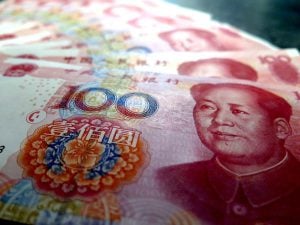The UK’s major financial institutions have agreed to give environmental finance greater priority this year through the ‘Green Finance Initiative’ (GFI) launched this week.
Major banks, asset managers and insurance companies will be among those aiming to increase the flow of projects eligible for green bonds that will fund cleaner energy and lower carbon infrastructure.
The GFI will also work to increase the quality and availability of information on green investments.
The green bond market doubled in size last year to around US$42 billion of issuance, but needs to expand at a much quicker pace if the world is to implement both the UN’s Sustainable Development Goals and the Paris climate change agreement.
Achim Steiner, Executive Director of the United Nations Environment Programme, told the ‘Year of Green Finance’ event in London: “2016 is set to be the year of green finance. Across the world, we are seeing a growing number of countries aligning their financial systems with the sustainability imperative.”
A UNEP report launched this week said the UK’s financial sector could play a major role in giving low carbon or sustainable investments a much bigger share of the US$90 trillion that the New Climate Economy think tank estimates will need to be spent on the world’s infrastructure over the next 15 years.
This year will also likely see efforts by China, as leader of the G20 in 2016, to deliver faster progress on environmental lending so that domestic and international investments can be made greener.
China, the UN, G20 and global financial institutions will this year aim to expand a system of green bonds to pay for the US$50 trillion of investment required to meet a 2C climate goal agreed at the Paris climate summit.
Green bonds, or climate bonds, are a relatively new asset class designed to raise finance for lower carbon investments such as renewable energy, mass transit systems and drought-resistant seeds.
The green bond market is forecast to grow to around US$100 billion this year. This would compare with an overall value of bond market estimated to be around US$80 trillion.
Green bonds will also be needed to fund a huge environmental clean-up following decades of rapid economic growth, particularly in large developing countries.
On January 24, the Green Finance Study Group (GFSG), which is chaired by the People’s Bank of China and the Bank of England, and includes the UNEP as an organiser, will launch in Beijing.
The new committee will focus on encouraging the private sector to funnel funds for low carbon infrastructure and development It will also make policy recommendations to the G20 when it meets in Hangzhou in September.
In December 2015, China issued new guidelines for green bonds, a critically-important step in increasing the flows needed to lower carbon investments.
According to experts, the green bond guidelines will help Chinese issuers reach out to a more diversified group of international institutional investors that can provide low-cost, long-term capital. In addition, China’s domestic issuances of green bonds would become increasingly relevant to international investors.
Green bonds
China needs 2 trillion-4 trillion yuan (US$300-600 billion) a year of finance for new, lower carbon infrastructure and cleaner air, water and soil, and these sums need to start flowing quickly, said Ma Jun, chief economist at the People’s Bank of China via a webcast.
“China has a huge environmental challenge, for instance, our levels of PM2.5 pollution are 20 times that seen in Australia, 75% of China’s water is polluted and a fifth of its arable land is contaminated,” Ma said.
Around 85% of the vast sums needed to tackle these problems, and make big cuts in carbon emissions, will need to come from the private sector, Ma added. At the same time, the policy agenda must focus on expanding the green bond market, green insurance and supporting financial disclosure.
“We need the right financial incentives to close the funding gap (for infrastructure),” said Elizabeth Corley, global chief executive officer at Allianz Global Investors.
Many environmental finance initiatives are in their early stages, held back by market uncertainty, and the size and age of other competitive markets, said Roger Gifford, chair of the GFI.
‘Fifty shades of green’
For the green bond market to mature, major economies and financial institutions will need to deliver clear progress on common standards on what constitutes a green investment.
“The questions that arise are, what is green and what is the quality control. Will we end up with 50 shades of green?” Gifford asked.
To be worthwhile, green bonds and other methods of environmental finance must have environmental credibility and provide decent returns for investors, said Steve Waygood, chief responsible investment officer of UK insurance company Aviva, which has a major presence in Asia.
But while China has tried to make its criteria for environmental finance more rigorous, the guidelines announced late last year will support some activities – such as cleaner coal generation – that would not be eligible for green bond status in many western financial institutions.
Calls for disclosure
Encouraging companies to disclose figures on greenhouse gas emissions and use of natural resources, such as water, is also needed besides green bonds, say financial institutions.
In December, Mark Carney, Bank of England governor and Michael Bloomberg, whose media company of the same name sells news and data to financial institutions, said they would head up a task force that would look at ways of compiling and presenting comparable environmental data on companies across the world.
“The Paris agreement put green finance at the core of markets around the world, and we now have greater opportunity to include particular assets (such as renewable energy) as well as excluding others (such as oil and coal), in investor portfolios,” said Allianz’s Corley.
At present, over 90% of companies listed on the UK’s FTSE 100 index disclose CO2 data, aided in part by UK company law, but in the Shenzhen stock exchange for example, the figure is still in single digits, according to figures compiled by Aviva and Corporate Knights Capital.
Poor corporate disclosure is making the assessment of environmental costs a challenging task for both Chinese banks and other investors, points out Chaoni Huang, a business development manager in Asia for Trucost, a data provider.
That may change if the government heeds the country’s central bank, which last year recommended that companies be forced to disclose environmental data. This would allow lenders to assess which companies are taking the least action to cut CO2.
Huang told chinadialogue in an email: “While it is not viable to stop lending to one particular sector or company overnight, we do hope to see that banks and other type of investors in China start to incorporate meaningful environmental metrics into traditional financial and risk assessment.”




![Many varieties of dhekia xaak (fiddlehead fern), which are extensively used in Assamese cuisine are disappearing with the changing climate. [image by Wikimedia/Tammy]](https://dialogue.earth/content/uploads/2016/01/fiddlehead-ferns-300x187.jpg)


